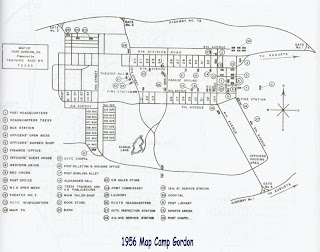In other words, was it going to be abandoned?
Both were finished training soldiers for combat and had the mission of discharging soldiers from active duty. Around 86,000 were discharged after WW2. POWs were repatriated.
In 1946, Camp Gordon had the task of jailing American servicemen who had committed felonies during the war. Does anyone know which area of Gordon was used for this task?
Then, within a few months in 1948, the 545th MP School was transferred from Carlisle Barracks, PA to Camp Gordon and a signal school was established in Camp Gordon, relieving the burden on Ft. Monmouth, New Jersey.
The signal school would soon become the USASESS or Southeastern Signal School.
This, along with a civilian affairs school gave credence to the future existence of the WW2 temporary camp near Augusta. Camp Gordon had a future established.
Picture from scholarblogs.emory.edu
The pennant with crossed pistols signifies the 545th MP school. More than any other transfer into the Camp, this MP school was of great significance.
This combination of pictures from Augusta.craigslist.com
Map from 545thmpassn.com
There is no source for this poster, although it pops up whenever trying to find anything relevant regarding the 545th MP school at Camp Gordon.
Photo from etsy.com
Is this T-shirt really from the 1950s?
To see MP school at Camp Gordon in the 1950s, click HERE.
Photo from gordon.history.army.mil
This may be out of historical sequence, but it is the headquarters of the Military Police School.
Photos from 545thmpassn.com
The Provost Marshall was the actual center of the Military Police at Camp Gordon.
Photo from 545thmpassn.com
This may be either the first or one of the first graduating classes from basic MP School. Before leaving Georgia, the MP School graduated over 150,000 MPs.
Photo from gordon.history.army.mil
Chances are that if you became an MP, you had your training at Camp Gordon after 1948. This class graduated in 1954.
Photo from gordon.history.army.mil
The MP School grew so fast that Camp Gordon quickly became the center for the training of MP officers such as this class in 1955.
Photo from hgdefaultytimg.com
This looks to be a typical duty of the MP which was to show a presence in a city or area.
Photo from eBay.com
Thus established, a post newspaper The Camp Gordon Rambler began publication. This newspaper would continue on for decades.
Photo by Robert W. Kelley
This picture is one of the few that could be found verifying the presence at Camp Gordon of the new signal school.
Climbing poles is an Army MOS that has been around since WW2. The above picture was taken in the 1950s, but could easily have been shot up to the present.
Map from realestatehunter.com
In the spring of 1956, Camp Gordon, with its future intact, had its name officially changed to Fort Gordon, Georgia.
Photo from gordon.history.army.mil
Major General John Brown Gordon, still dead, had no comment on his name being used for the third time.
This is actually the third different picture of the General we have used in the Fort Gordon history.
For all of the postcards pictures and descriptions, this map is actually the first one we were able to find. Although it says Camp Gordon, within months it became Ft. Gordon.
This map is very close to the way Ft. Gordon looked when we arrived in 1967. Its features will be referred to again in future posts.
This map is very close to the way Ft. Gordon looked when we arrived in 1967. Its features will be referred to again in future posts.
Picture from pinterest.com
This may be a little early in the Fort's existence. The entrance still indicates the 3rd Army Training Center, meaning basic infantry combat training.



































